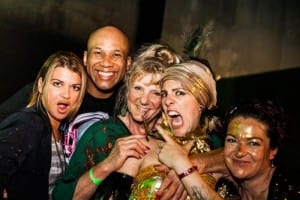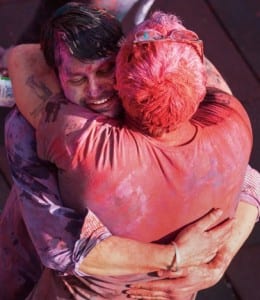 There is a inaudible and under-examined plight in the world: we are forgetting how to play. Cross cultural studies on children’s play are alerting us to the rapid decrease in children’s ability to enter in fantasy play and a severe decrease in both free play and experiential learning. Imaginative and pretend play is becoming rare, regardless of where a child lives or goes to school. Adults are not faring much better, and I can confess to my own loss of playfulness. The lack of play in our lives is outright frightening.
There is a inaudible and under-examined plight in the world: we are forgetting how to play. Cross cultural studies on children’s play are alerting us to the rapid decrease in children’s ability to enter in fantasy play and a severe decrease in both free play and experiential learning. Imaginative and pretend play is becoming rare, regardless of where a child lives or goes to school. Adults are not faring much better, and I can confess to my own loss of playfulness. The lack of play in our lives is outright frightening.
I don’t play enough. I know it and it is turning me into a tiresome and anxious person who frets night and day about our business and the tedious challenges of self-employment, not to mention the horrid state of the world. Growing older adds to my frustration as I am forced to accept the limitations of my life and the many unfulfilled dreams I have carried for decades. I am tethered to my desk; tethered to habitual habits; and tethered to obsolete assumptions about responsibility, money, time and life. I don’t move enough. I don’t sleep enough. I don’t laugh enough…and I don’t see other people playing enough.
I know better. I know that play is the springboard of all learning. I know that flirtation, fantasy, risk-taking, curiosity, novelty, discovery, amusement, laughter and physical movement are components of learning. Play connects us to others, promotes bonding and develops empathy, trust, compassion and the capacity for intimacy. It fosters flexibility, perseverance, creativity and fuels our imaginations. I just keep forgetting this and find myself falling into destructive patterns. I’ve sacrificed myself in order to be responsible, and probably failed at that. It seems I have a lot of company.
 “Be a kid your whole life” my parents used to say. They spent their lives playing and taught others how to do it. Their curriculum for early childhood education was titled “Playway: Education for Reality- An Interest/Play Center Approach for Education” and it espoused play as the natural method of learning. My parents designed playgrounds in the spirit of Lady Allen (Marjory Allen, Baroness Allen of Hurtwood), the English landscape architect and promoter of child welfare, who built adventure playgrounds out of the ruins of WWll and understood that children needed to take risks and get dirty with stones and sticks and water. My memories of an elderly Lady Allen getting off an airplane with a skate board under her arm, which she immediately mounted, still keeps me chuckling. My earliest theater mentor was Peter Slade, a British dramatist who in the 1920’s was the first person to point out that there exist a Child Drama, an art form in its own right with its own shape and development- all based upon play…and that play itself was the key component to human development.
“Be a kid your whole life” my parents used to say. They spent their lives playing and taught others how to do it. Their curriculum for early childhood education was titled “Playway: Education for Reality- An Interest/Play Center Approach for Education” and it espoused play as the natural method of learning. My parents designed playgrounds in the spirit of Lady Allen (Marjory Allen, Baroness Allen of Hurtwood), the English landscape architect and promoter of child welfare, who built adventure playgrounds out of the ruins of WWll and understood that children needed to take risks and get dirty with stones and sticks and water. My memories of an elderly Lady Allen getting off an airplane with a skate board under her arm, which she immediately mounted, still keeps me chuckling. My earliest theater mentor was Peter Slade, a British dramatist who in the 1920’s was the first person to point out that there exist a Child Drama, an art form in its own right with its own shape and development- all based upon play…and that play itself was the key component to human development.
Slade’s work is echoed in the contemporary research of Dr. Stuart Brown, founder of The National Institute for Play – a non-profit research facility committed to bringing the unrealized knowledge, practices and benefits of play into public life using science to discover all that play has to teach us about transforming our world. It is Dr. Brown’s research that reminds us that an alarming pattern in killer’s stories is a lack of play in childhood; that play is a core element in success; and that play is the evolved behavior important for the well-being — and survival — of animals, especially those of higher intelligence.
Play scientist tell us stories about animals imitating play with predators to escape from death; stories of engineering firms giving hiring preference to job candidates who tinker with machines for fun over those applicants excelling at theoretical mathematics; stories of play-deprived rats entering adulthood unable to tell friend from foe and lacking any skills to mate properly; and stories of play deprived adults who cannot cope with normal stresses of life and experience various forms of addiction and depression – or worse, become murderers. The idea that seemingly purposeless and trivial forms of play can inspire development of critical skill in animals, adults and children has potentially far reaching significance for how we think about human survival.
Play scientists agree that play seems to be one of the most advanced methods nature has invented to allow a complex brain to emerge and that play offers the benefits of learning to adapt to a changing world by creating imaginative new cognitive combinations that can be tested and explored to find what works. When you watch a child play you will likely witness the child making up pretend stories about everything they see. They are combining spontaneous imagination with the environment they’re seeing—attempting to create an internal narrative that gives them a sense of comfort and allows them to navigate. Half of the stories are the concoctions of their imaginations, and the remaining half is related to the reality in front of them. Children live in a delicious balance between fantasy and reality, and this is the means by which play and imaginations become problem solving. Resiliency, the ability to handle unexpected things, emotional competence, empathy, problem solving, creativity—these are built through play.
Adults who forget how to play become rigid, narrow minded, brittle in their response to stress and much less open to handling the changes life presents to us. Rolling with the punches becomes much harder and rage reactions are easier. Brian Sutton-Smith, author of Play As Emotional Survival, states it simply: “The opposite of play is not work, it’s depression.”
Somewhere along the way most of us have forgotten how to play and become strangers to the abandonment and joy of childhood. In the words of scientist Gordon Burghardt, from the University of Tennessee: “The problem of defining play and its role is one of the greatest challenges facing neuroscience, behavioral biology, psychology, education and the social sciences generally… only when we understand the nature of play will we be able to understand how to better shape the destinies of human societies in a mutually dependent world, the future of our species, and perhaps even the fate of the biosphere itself.”
 Play can exist in matters of degree. An activity can be characterized as play, or described as playful, to the degree that it contains the characteristics of being self- chosen and self-directed; imaginative; intrinsically motivated; conducted in an active, alert, but relatively non-stressed frame of mind; and guided by mental rules. We play when we lose ourselves creating an artistic expression. We play when we come in contact with babies and jabber in ‘baby talk’. We play when we rough house with our pets or enter into a soccer game with our neighbors or co-workers. We play when we jump in a puddle and cease caring about our shoes. Play beckons us from every corner but how rarely we accept the invitation.
Play can exist in matters of degree. An activity can be characterized as play, or described as playful, to the degree that it contains the characteristics of being self- chosen and self-directed; imaginative; intrinsically motivated; conducted in an active, alert, but relatively non-stressed frame of mind; and guided by mental rules. We play when we lose ourselves creating an artistic expression. We play when we come in contact with babies and jabber in ‘baby talk’. We play when we rough house with our pets or enter into a soccer game with our neighbors or co-workers. We play when we jump in a puddle and cease caring about our shoes. Play beckons us from every corner but how rarely we accept the invitation.
If play is so essential to the world, what do we do about it? How do we play? And how do we find playmates? In Ningbo it seems easier than it is in my neck of the world. I am nourished each time I come to visit since I always find eclectic and energetic people from all over the world and they seem committed to sharing mutual amusement (although I rarely see children in abandoned play). Yet, my living and working in the middle of America is no excuse. Regardless of where or who we are, we need to attune our attitudes to playfulness.
Please. Play with a kid whenever possible, even if only for a few minutes. Playing with kids helps us experience the magic of play through their perspective. Find playful people and surround yourself with more of them. Play with your loved one. Stop caring if the laundry gets done. Play and talk more to animals and pets.
Read aloud to someone. Some writers are meant to be read aloud: Carl Sandburg, Frank McCourt, David Sedaris, Emma Bombeck, Dylan Thomas, Maurice Sendak, and Dr. Suess to name a few. They will make you laugh right out loud.
Get physical. Staying physical is essential. Learning about self-movement structures an individual’s knowledge of the world – it is a way of knowing, and we actually, through movement and play, think in motion. Movement lights up the brain and fosters learning. If you are older, ask yourself the last time you skipped down the pavement?
Babble with a baby – even if it’s only for a minute while standing in line at a grocery store. There’s strange magic to baby talk and it always produces giggles. This is called Attunement play. It is known, through EEG and other imaging technologies, that the right cerebral cortex, which organizes emotional control, is “attuned” in both infant and adult with eye contact.
 Skip a rock, bang a pan, and find an object to play with. Hands playing with all types of objects help brains develop beyond strictly manipulative skills, with play as the driver of this development. Wrestle with your partner – even if you feel awkward, overweight, or embarrassed.
Skip a rock, bang a pan, and find an object to play with. Hands playing with all types of objects help brains develop beyond strictly manipulative skills, with play as the driver of this development. Wrestle with your partner – even if you feel awkward, overweight, or embarrassed.
Create time for fantasy, day-dreaming or in my case, dramatic character creation. Tell more stories and honor the fact that storytelling has been identified as the unit of human intelligibility. Stories told well share the capacity to produce a sense of timelessness, pleasure and the altered state of vicarious involvement that identifies narrative with states of play.
Be a clown. Smash a watermelon or try a hula hoop. Celebrate India’s Holi and throw color into the air. Do something unreasonable as often as possible.
Be purposeless.
Play is the purest expression of love. It just might save us.

